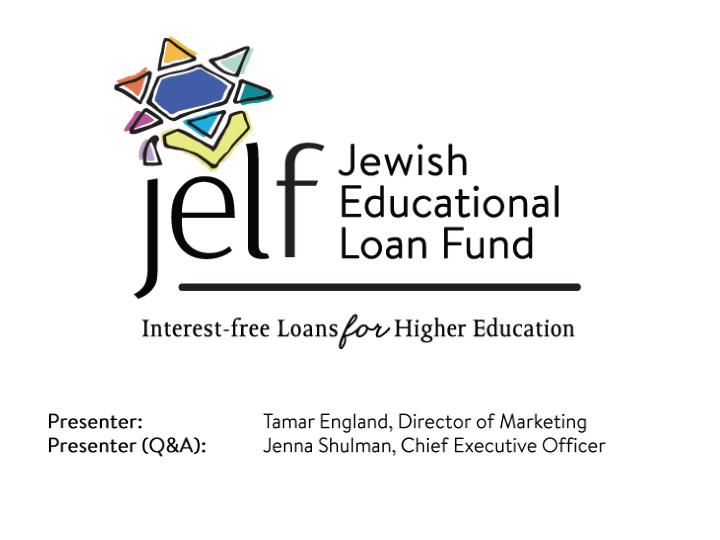



Webinar Overview (approx. 30 min) • Program Background • Criteria • What Makes JELF Different? • How Decisions are Made • Our Impact & Marketing • Q&A Hannah Zazzaro University of Cincinnati Graduate
Mission: JELF provides interest-free loans to Jewish students in need for higher education. • Serves a 5-state region • Florida • Georgia • North Carolina • South Carolina • Virginia (excluding metro DC) • Provides “last dollar” loans, bridging the gap between financial aid received and total amount a student Jeremy Chartash needs. Currently a fellow in ophthalmology at the CDC Foundation
Over a century of deep-rooted history 1889 1930 1989 Hebrew Jewish JELF Orphans’ Children’s Home Service Located in Atlanta and The organization was The Hebrew Home established in the formally changed to the closed and evolved into former B’nai B’rith Jewish Educational Loan Jewish Children’s District No. 5 region, Fund (JELF) Service, which began this institution housed, providing interest-free fed, educated and loans in 1961. provided instruction to orphaned Jewish children
Rising Cost of College in the United States In 18 years, a 4-year college degree could cost about $500,000!
JELF Loan Criteria: • Jewish (self-identified/raised) • Legal resident of FL, GA, NC, SC or VA (excluding metro DC) • Enrolled full-time in a U.S. accredited institution • U.S. citizen (or have lawful immigration status) • Be in good academic standing (must meet at least a 2.0 GPA) • Have a co-signer • Demonstrate financial need Benjamin Warsaw Asst. Professor of Music, Armstrong State
What Makes JELF Different?
1. Interest-Free Lending $5,000 loaned to student Private Loan JELF Loan 7% interest 0% interest (average) unsubsidized always subsidized Amount Due: Amount Due: $5,000 $7,975 Save up to $2,975 on the average $5,000 JELF loan * This assumes that both loans have the same repayment period.
2. JELF offers choice so that recipients can attend the university that is the best fit for their needs.
What Makes JELF Different? 3. Last Dollar Lending. Students do not request a certain amount. Financial need is determined through JELF’s unique “last dollar” formula.
How Does JELF Calculate a Last Dollar Loan? Cost of School: In 2017, Emory University costs $69,015, including tuition, books, room/board, transportation and miscellaneous expenses. Student’s Financial Package: JELF then documents exactly what this same student has already secured financially, including help from family members, scholarships and/or other loans. In this case, let’s say that amount is $63,537. $69,015 (total cost of school) - $63,537 (student’s financial package) ______________ = $5,478 (this student’s total need)
4. What Makes JELF Different? Personal Approach.
JELF’s 22 Partnership Agencies To locate the JELF representative in your area, please visit jelf.org/mylocaljelf
What Makes JELF Different? 5. Graduated Repayment. JELF recipients never pay anything back until 6 months after their final graduation, at which time monthly payments start off very low and gradually increase throughout an 8- year period.
JELF Process: The Basics
• Per year : Students must apply for a loan each year Undergrad that they are in school. • Two-Step Process: Grad School – Complete online application – Personal interview Vocational • Application Periods: Online application available 2 times/year Tech School
When To Apply 2 application periods per year
The Online Application Process Upload supporting documents including: - Transcripts - Tax returns - W2/1099 Forms - The Student Aid Report (SAR), received after filing FAFSA - FAFSA available online beginning October 1 In-person interview (first-time applicants and their co- signers) or phone conversation with your Local JELF Administrator (LJA) Submit final supporting documents : - Final transcripts - Financial aid award from university/program - Cost of school `
How Decisions Are Made 1. May – June (or Oct) – Applications are processed, stripping all identifying information, including name and gender. 2. Late-July (or late-Nov) – JELF donors and Board Members discuss and vote on each application individually, based on JELF’s criteria. 3. Late-July (or late-Nov) – Students are notified about their award amount. 4. Early-August (or late-Nov) - Students sign a promissory note and receive their JELF loan check. If the awarded amount is in August for full year, student receives 50% of the loan now and the remaining 50% in December.
Marketing to Applicants • Annual Mailing: 800+ entities around JELF’s 5 -state region receive a mailing with material. This includes: – Synagogues – Public/Private high school – Hillels and on-campus Chabad – Jewish fraternities & sororities – College Financial Aid offices – College Placement Specialists • Word of Mouth: Hundreds of conversations and info sessions taking place each year across the region • Social Media: JELF’s Facebook page promotes application season throughout the year.
JELF by the Numbers
• On the streets : $5.8 million currently loaned to 839 students in 5 states • Recycling: With a 99% repayment rate, 456 of those loans are currently being paid back to help future recipients • Educating: There are an additional 383 students who are still in school with a JELF loan and will begin to repay in the near future Lauren Vargas Dental resident at NYU
JELF’s Impact
• JELF has granted $7.1 million in loans over the past 10 years, representing a total of 1,803 loans • JELF has thousands of recipient alumni living all over the U.S. who credit JELF, in part, for their success • JELF inspires our Jewish communities to recognize that these situations exist and that we can help students in need continue to pursue their higher education. Sydney Lewis Graduate of Wesleyan University
Q&A
Recommend
More recommend